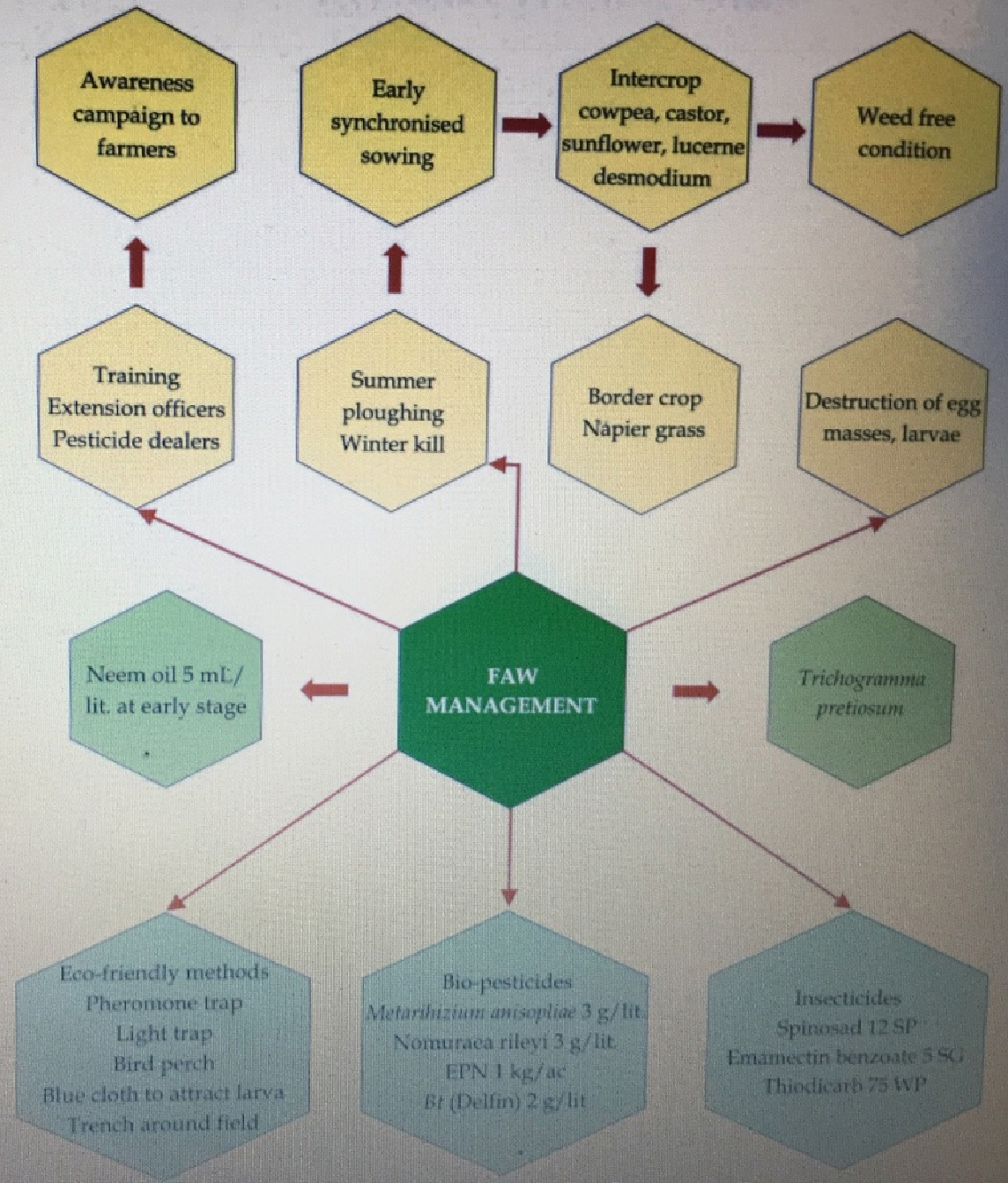
Dr. Hannah Krujia
ACTO Agronomy
KVK Phek
Fall Armyworm (FAW) (Spodoptera frugiperda) is an insect that feeds on more than 80 crop species, causing significant damage to economically important cultivated cereals such as maize, rice, sorghum, and legumes as well as vegetable crops and cotton. High infestations of the insect can lead to significant crop loss. In India, FAW has been reported during May 2018 in Karnataka. In northeast India, this invasive pest was reported for the first time during late March 2019 in Lunglei district of Mizoram and West Tripura district of Tripura state. Subsequently, it has detected causing massive outbreaks during April in Mizoram, Meghalaya, Manipur, Sikkim, Arunachal Pradesh and Nagaland.
Important facts about the fall army worm:
- Fall armyworm moths lay eggs at night on the lower leaves in tight clusters of 150-200 eggs.
- Fall armyworm larvae attack plants as early as the third leaf stage.
- The caterpillars that cause the damage are most active in the early morning, and in the later afternoon and evening. Therefore, this is the best time to use pesticides or other control measures.
- Fall armyworm has four life cycle stages: egg, caterpillar (larvae), pupa, and moth.
- Adult moths are strong fliers and capable of travelling long distances.
- Tropical rains can break the life cycle of Fall armyworm by washing eggs off leaves and onto the ground. They can also drown young larvae in maize whorls, causing high levels of mortality.

How to manage/control FAW in maize
- Monitoring - One week after maize germinates, farmers should monitor their fields for the presence of the pest or symptoms of feeding.
- Scouting – Field scouting in ‘W’ manner should be done immediately after the maize seedlings emerge
- Cultural Measures:
- Deep ploughing is recommended before sowing. This will expose FAW pupae to the predators.
- Remove and destroy all the previous crop residues.
- Timely sowing is advised.
- Avoid staggered sowing.
- Intercropping of maize with suitable pulse crops that are known to repel or confuse female moths and stop them from laying eggs on maize plants. (eg. Maize + pigeon pea/black gram /green gram)
- Sowing of 3-4 rows of trap crops (eg. Napier) around maize field and spray with 5% NSKE or azadirachtin 1500 ppm as soon as the trap crop shows symptom of FAW damage.
- Clean cultivation and balanced use of fertilizers.
- Cultivation of maize hybrids with tight husk cover will reduce ear damage by FAW.
- Mechanical control :
- Hand picking and destruction of egg masses and larvae in mass by crushing or immersing in kerosene water or hot water.
- Application of dry sand or sawdust, soil, soap solutions in to the whorl of affected maize plants soon after observation of FAW incidence in the field.
- Mass trapping of male moths using pheromone traps @ 5/acre.
- Bio-control strategies
- In situ protection of natural enemies by habitat management: Increase the plant diversity by intercropping with pulses and ornamental flowering plants which help in build-up of natural enemies
- Augmentative release of Trichogramma pretiosum Or Telenomus remus @ 50,000 per acre at weekly intervals or based on trap catch of 3 moths/trap
- Biopesticides: Entomopathogenic fungal formulations: Application of Metarhizium anisopliae talc formulation (1x108 cfu/g) @ 5g/litre whorl application at 15-25 days after sowing. Another 1-2 sprays may also be given at an interval of 10 days depending on pest damage or
- Nomuraea rileyi rice grain formulation (1x108 cfu/g) @ 3g/litre whorl application at 15- 25 days after sowing. Another 1-2 sprays may also be given at an interval of 10 days depending on pest damage
- Application of Bacillus thuringiensis var kurstaki formulations @ 2g/litre (or) 400g/acre.
- Stage wise options including chemical control:
- First Window (21 – 28 days after emergence): To control FAW larvae at 5% damage to reduce hatchability of freshly laid eggs, spray 5% NSKE or Azadirachtin 1500 ppm @ 5ml/ litre of water.
- Second window (35 – 49 days after emergence): To manage 2nd and 3rd instars larvae at 10-20% damage spray Spinetoram 11.7% SC @ 0.5 ml/litre of water or Thiamethoxam 12.6% + lambda cyhalothrin 9.5% @ 0.25 ml/l of water or Chlorantraniliprole18.5% SC @ 0.4 ml/litre of water.
- Poison baiting: Poison baiting is recommended for late instar larvae of second window. Keep the mixture of 10 kg rice bran + 2 kg jaggery with 2-3 litres of water for 24 hours to ferment. Add 100 g thiodicarb just half an hour before application in the field. The bait should be applied into the whorl of the plants.
- Third Window (56 days after emergence to tasseling and post tasseling): Insecticide management is not cost effective at this stage hence, hand picking of the larvae is advisable

Source:
-
- Technical Bulletin: Integrated management of fall army worm in maize. ICAR – NIBSM, 2019.
- Farm Radio International, 2017




